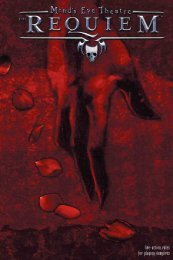Create successful ePaper yourself
Turn your PDF publications into a flip-book with our unique Google optimized e-Paper software.
a history of the ordo dracul<br />
in the late 1930s. The tale, scribed by a Turkish chronicler<br />
in Egrigoz, in Asia Minor, speaks of a “young man<br />
with light skin, but dark eyes, and his brother, who at<br />
first blush appeared to be a woman. I watched them together,<br />
and the older one said to the younger, ‘I have<br />
remained pure and kept my mind and heart free of these<br />
infidels’ rantings, while you are one short step from bending<br />
knee to their God. But know this: Nightly our brother<br />
and father visit me, and tell me of dark and terrible things<br />
in my future. I shall see the day when the unconquerable<br />
shall fall and the circle is broken, but you shall die<br />
upon broken promises and in great agony.’”<br />
This tale seems to refer to the Invictus (“the Unconquerable”)<br />
and the Circle of the Crone (“the Circle”), and<br />
as the Rites of the Dragon indicate, Dracula would later have<br />
dealings with both covenants, though of course they did<br />
not suffer any kind of defeat at his hands. More interesting<br />
is the reference to Dracula’s father and brother visiting him<br />
and telling him of the future. While it’s possible that Dracula<br />
was simply lying to his brother in order to frighten or shame<br />
him, the fact remains that Radu the Handsome did indeed<br />
die of a “broken promise.” According to the Rites of the<br />
Dragon, Dracula impaled his brother upon a stake after<br />
promising, falsely, to Embrace him once he died.<br />
The second piece of evidence linking Dracula to the<br />
supernatural, indeed to the Kindred, while he was mortal<br />
comes from an extremely dubious source. This incident<br />
supposedly took place in 1911. A Kindred historian<br />
of the Libitinarius bloodline attended her sire, along<br />
with two other observers of different clans, while the<br />
sire lay in torpor, recording his fevered dreams through<br />
the use of Auspex. One of them later stated that “she<br />
[the historian] began to convulse, her nose and eyes leaking<br />
profuse amounts of blood so dark it resembled pitch<br />
in the dim light. As she did so, her hand continued to<br />
work upon the page, but instead of writing fragmented<br />
sentences culled from her torpid sire’s mind, she wrote<br />
in clear, precise script, albeit in a language with which I<br />
was unfamiliar. At the end of the script was a signature<br />
that filled me with dread: DRAKULYA, A.D. 1459.”<br />
What the “Libitinarian script,” as it is known among the<br />
Dragons, actually said was never revealed. All four Kindred<br />
— the sire, the childe and the two observers — perished in a<br />
fire later that year, and the script itself vanished. Rumor has<br />
it that the Kogaion of an unknown city has part or all of it in<br />
her possession. If this is true, surely some members of the<br />
Libitinarius bloodline would give much to obtain it.<br />
✫✹★✪✼✳★’✺✂✫✬★✻✯✂★✵✫✂✹✬✩✰✹✻✯<br />
Vlad Dracula died, as far as the mortal world knows,<br />
in 1476 near Bucharest. As with many famous leaders,<br />
fantastic stories and conspiracy theories about his death<br />
abound. The most famous is that he dressed as a Turk to<br />
escape his enemies and was subsequently killed by his<br />
own men. In any case, his story doesn’t end there.<br />
21<br />
chapter one<br />
6



